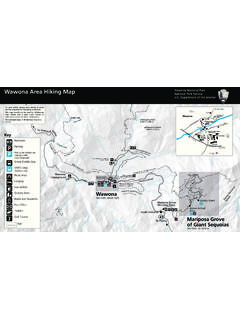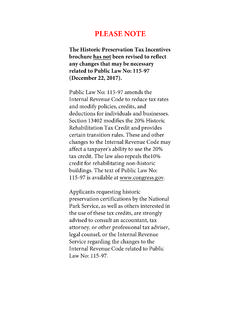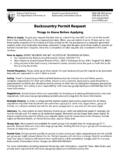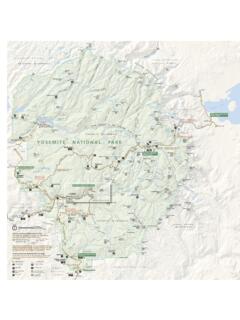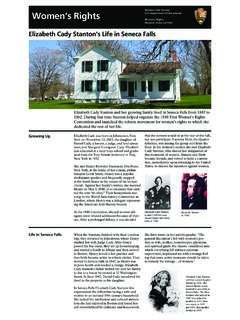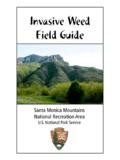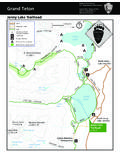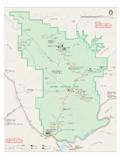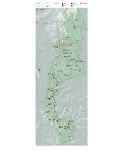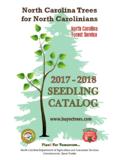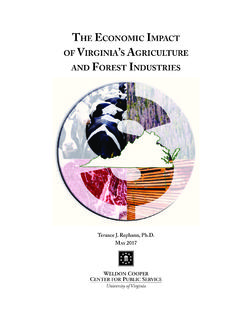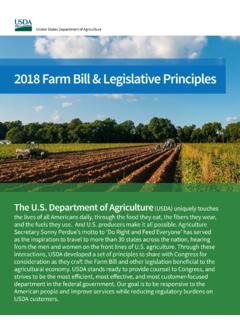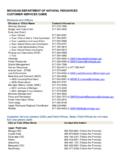Transcription of Forest Service National Park Service U.S. Department of ...
1 National park Department of the InteriorForest Department of AgricultureBureau of Land Department of the Fish and Wildlife Department of the InteriorJr. Ranger Activities and Adventures for Ages 8 and upWilderness Explorer50thAnniversaryEdition2 Welcome to WildernessThis activity booklet is designed for exploring wilderness, either at a wilderness area you are visiting, one near your home, one you would like to visit, or one you just want to study. Activities are geared for ages 8 and up, so look for the bear paw and choose the activities that are right for you. Ages 8 and upAges 12 and upASK A WILDERNESS RANGER! As you explore, you may find it helpful to ask a ranger or look for information in a visitor center. You and your adult can also look for information on the internet. Five great places to learn more about wilderness: Wilderness Bureau of Land Management Forest Service National park Service Fish and Wildlife Service to many of of the activities can be found on page EXPLORING!
2 Special PlacesDraw or describe a place that is SPECIAL to you in this space. Why is it special?What does the word WILD make you think of? Draw or describe it might be SPECIAL about a place that is WILD? Draw or desribe it 16 and up3 Ask 3 people what they think Wilderness is. Record their responses Person interviewed: Wilderness Person interviewed: Wilderness And Wilderness Ideas3. Person interviewed (could be a wilderness volunteer or ranger): _____ Wilderness : A. a home for wild animals B. a quiet place to think C. a place to be free D. your idea A wilderness, in contrast with those areas where man and his own works dominate the landscape, is hereby recognized as an area where the earth and its community of life are untrammeled by man, where man himself is a visitor who does not remain.
3 4 Vocabulary: Trammel refers to a net, or a shackle for horses. Most generally, it means a barrier to free action; a restraint. 2014 is the 50th anniversary of the Wilderness Act. In honor of the Wilderness Act s 50th birthday, think about this: What does wilderness mean to you? Use the space below to capture your ideas with words and/or Is Wilderness?WILDERNESS is an area that is .. know what it means to be wild - when you are free to follow your own will. When you aren t controlled by the following description of wilderness by using these words to fill in the blanks: will controlled free nature cut changed In wilderness, nature follows its own _____. The animals aren t _____. The trees are not _____. The rivers run _____, without dams. Visitors enjoy being in _____ as it was before modern humans _____ it. *In 1964, Congress passed the Wilderness Act, recognizing that certain wild places are special and worthy of being protected forever.
4 Here is the definition of wilderness from the Act:Native American cultures believe that all land ought to be respected, and may not view wilderness as a separate idea. will, controlled, cut, free, nature, changed* Hold booklet to a mirror to find the order of the missing words:5 Wilderness Explorers need to know how to be safe when they re exploring the wilderness. Being safe in wilderness begins before you start your trip. Always go with another the weather and conditions for the area you are someone who is staying behind exactly where you are going and when you plan to return. Wilderness There are 10 essentials you and your adult should have with you to be safe and prepared for emergencies. A box is drawn around each essential item. Write the name of each item on the What else would you like to bring? Circle the items below. Don t make your pack too heavy!
5 TEN ESSENTIALS6 Where Is Wilderness?Ask a wilderness ranger (or check the visitor center or the internet): How much wilderness is in this Forest or park ? Just for fun, color all the states you have or name something you would find in wilderness in or name something you would find in wilderness in the map at the right, find the answers:1. How many wilderness areas are in your home state? 2. How many wilderness areas are in the state you are visiting? 3. Which state has the greatest number of wilderness areas?4. Six states have no wilderness areas. Name them here: There are over 758 wilderness areas containing nearly 110 million acres of wilderness. The Bureau of Land Management manages 221 wilderness areas (8% of the land area within the National Wilderness Preservation System [NWPS]). The Forest Service manages 439 units (33% of the land area within the NWPS). The National park Service manages 62 units of wilderness (40% of the land area within the NWPS).
6 The Fish and Wildlife Service manages 72 units (18% of the land area within the NWPS).7 Are We There Yet?Put an X on the Olympic Wilderness and the Saguaro Using the ruler below (cut it out if needed), estimate the distance between the two wilderness areas: Suppose that you and your family could drive from one to the other at 60 miles per hour (mph). How long would it take to get there? Hint: distance ____(miles) speed _____ (mph) = time _____(hours).What might you find that is different between the two wilderness areas? Which wilderness area named below is closest to: New York City? _____ Denver? _____ San Francisco? _____020040060080010001200 The names are just a few of the wilderness areas in National forests and Was Here Before?Ask a wilderness ranger (or check the visitor center or the internet):1. What people lived here before the Europeans came?2. Did these people live in villages or did they move their homes to follow and hunt animals?
7 Draw a picture of where they might have lived below:3. What things might these people have eaten (such as roots, berries, buffalo)? List or draw a picture below:4. Do these people or their descendants still live here or near here?Important: If you find any arrowheads, pieces of pottery, or other old objects be sure to leave them where you found them so that archaeologists can reconstruct history!Answer the first four questions, plus:5. Did these people have names for any of the natural features such as mountains, rivers, or valleys? Write down one of the names here:6. Is this name different than the one on the area map?9 BACKPACKINGCONTRASTFREEFUTURE HIKINGHORSEBACKNATURALPHOTOGRAPHINGPRESE RVEPRIMITIVEQUIETRECREATIONRESEARCHSCENE RYSOLITUDESPIRITUALUNCONFINEDUNDEVELOPED UNIQUEUNSPOILEDUNTRAMMELEDVIEWSWATERSHED WILDW ords may be horizontal, vertical, or diagonal - left to rightFind at least 8 wordsFind at least 12 wordsWilderness Word SearchFind at least 16 words10 Leave No TraceThe Wilderness Act defines wilderness as a place where man himself is a visitor who does not remain.
8 How can you be a responsible Wilderness Explorer? The Seven Principles of Leave No Trace are a good starting place:1. Plan ahead and prepare2. Travel and camp on durable surfaces3. Dispose of waste properly4. Leave what you find5. Minimize campfire impacts6. Respect wildlife7. Be considerate of other visitorsGo through the maze on the next page and apply these Leave No Trace on your public lands!Pick up three pieces of litter and put them in the learn more about Leave No Trace visit www. up a bag of litter and put it in the up a bag of litter. Separate and recycle as many items as possible. Put the remainder in the is better for the Earth than putting things in a landfill, but it still takes a lot of energy to recycle. REUSE is even better for the Earth. Refill you water bottle and conserve the Earth s for fun, decorate and color the water bottle in this book or your own water you ever hear the phrase Leave only only photographs?
9 Even a footprint can leave an impact. Please be thoughtful of where you No Trace MazeThese Wilderness Explorers are about to go on a trip through a Wilderness. Help them make the best choices about where to go and what to do along the way. Each stop has a numerical rating with it. Add up your score & find your impact level on page 21. pointsA. 1B. 2C. 1D. 3E. 2F. 1G. 5H. 1I. 5J. 1K. 5L. 1M. 1N. 3O. 5P. 1Q. 1R. 1my total____12Be a ScientistWilderness is a place where scientists can go to understand plants, animals, and landscapes that are in a natural state, unaffected by human a scientist, you will ask a question, make a prediction (called a hypothesis), and test your hypothesis by observing the thing you asked a question Go outside and find a plant or animal to observe. Describe it here with words and/or pictures:2. Come up with a question about it. For example, what does this bird eat?
10 Does this plant prefer to live in dry soil or wet?3. Make a hypothesis. This is an educated guess about the answer to your question. For example, I think that the bird eats .. or I think that the plant will grow in soil that is .. 4. Think about and describe how you could test your hypothesis. If it is possible to test the hypothesis by making observations, then do so. If not, think about what kinds of observations you can make. For example, I will observe the bird and see what it 13Be A Scientist5. Write down your observations Do you think the animal or plant you observed was affected by people being nearby? If so, how?Complete the six previous questions, plus ASK A WILDERNESS RANGER (or check the visitor center or internet): What kinds of research are going on in the wilderness you are visiting or studying?Complete the seven previous questions, plus:8. Develop a hypothesis that would best be tested both inside and outside of wilderness.
